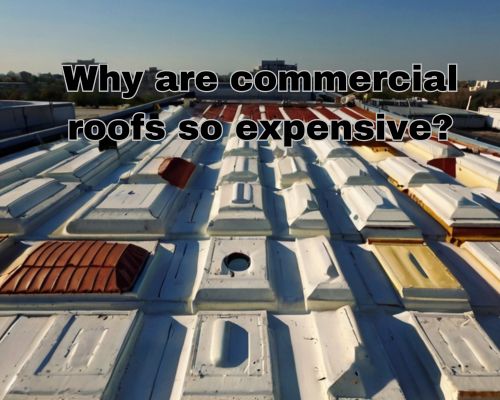
Why Are Commercial Roofs So Expensive?
Why Are Commercial Roofs So Expensive?
Commercial roofing is a critical investment for businesses, particularly in New Jersey, where diverse weather conditions can take a toll on building structures. Understanding why commercial roofs are expensive requires a deep dive into materials, labor, regulations, and unique challenges specific to the Garden State. If you’re planning a commercial roofing project, this guide will shed light on what drives costs and how to optimize your budget without compromising quality.

1. High-Quality Materials for Durability and Performance
One of the primary factors contributing to the expense of commercial roofs is the materials used. Unlike residential roofing, commercial roofs must withstand higher loads, greater exposure to environmental stress, and frequent foot traffic.
Popular Roofing Materials and Costs
- TPO (Thermoplastic Polyolefin): Widely used in New Jersey for its energy efficiency and affordability. Costs typically range from $5 to $10 per square foot installed.
- EPDM (Ethylene Propylene Diene Terpolymer): A durable option known for its resistance to extreme weather, priced around $8 to $12 per square foot.
- Metal Roofing: Highly durable and reflective, but costs can climb to $10 to $25 per square foot depending on the type of metal.
These materials are designed to meet stringent safety and performance standards, particularly in areas like New Jersey, where hurricanes and heavy snowfall can be factors.
2. Labor Costs and Specialized Expertise
Commercial roofing requires skilled labor due to the complexity of installation. Roofers in New Jersey often need to be certified and trained to work with specific materials and comply with local building codes, just like CJ Commercial Roofing NJ. Labor costs in the state can account for up to 50% of the total roofing expense.
Why Labor Costs Are High in NJ
- Unionized Workforce: Many roofing companies employ unionized labor, which ensures fair wages but increases costs.
- Specialized Skills: Installing systems like built-up roofs (BUR) or green roofs requires advanced training and certification.
- Safety Compliance: OSHA regulations mandate safety measures such as harnesses, scaffolding, and permits, adding to labor costs.
3. Local Building Codes and Regulations
In New Jersey, commercial roofing projects must comply with strict building codes, which are designed to protect structures from the state’s variable climate. These codes often require permits, inspections, and adherence to energy efficiency standards, all of which increase costs.
Key Considerations in NJ
- Energy Efficiency Mandates: Many municipalities in New Jersey enforce the International Energy Conservation Code (IECC), which impacts material and installation choices.
- Storm-Resistant Requirements: Roofs must meet wind uplift standards, especially in coastal areas like Atlantic City or Cape May.
- Green Building Initiatives: Businesses in urban centers such as Newark or Jersey City may opt for environmentally friendly roofing options to meet sustainability goals, often leading to higher upfront costs.
4. Weather Challenges in New Jersey
New Jersey’s climate is a mix of hot, humid summers and cold, snowy winters, both of which impact the longevity and performance of commercial roofs. Roofing systems must be designed to handle:
- Heavy Snow Loads: Especially in northern regions like Sussex County.
- High Winds and Storms: Coastal cities like Hoboken and Asbury Park frequently experience strong storms that necessitate reinforced roofing systems.
- UV Damage: Summers in New Jersey can reach temperatures that accelerate wear and tear on roofing materials.
To counter these challenges, many businesses invest in weather-resistant materials, thermal insulation, and protective coatings—all of which add to the cost.
5. Maintenance and Lifespan Considerations
Investing in a commercial roof is not just about upfront costs; maintenance and lifespan are significant factors. A poorly maintained roof can lead to leaks, structural damage, and costly repairs, particularly in a state like New Jersey where precipitation averages over 40 inches annually.
Proactive Maintenance Saves Money
- Regular Inspections: Quarterly inspections can identify potential issues before they escalate.
- Protective Coatings: Many business owners in New Jersey apply reflective coatings to prolong the lifespan of their roofs and reduce cooling costs.
- Gutter and Drain Cleaning: Clogged gutters can lead to water pooling, especially during heavy rainfall common in cities like Trenton and Paterson.
6. How to Optimize Costs Without Compromising Quality
While commercial roofs are undeniably expensive, there are ways to manage costs effectively:
- Compare Quotes: Get estimates from multiple roofing contractors in New Jersey to find competitive pricing.
- Energy Efficiency Rebates: Look into state and federal incentives for energy-efficient roofing systems, which can offset costs.
- Long-Term ROI: Focus on materials with longer lifespans and warranties to reduce long-term expenses.
Trusted Roofing Contractors in NJ
Working with experienced contractors who understand New Jersey’s unique roofing needs is essential. Look for companies with a track record of successful installations in local climates.
Conclusion
Commercial roofs are expensive due to the high-quality materials, skilled labor, and stringent regulations required to ensure durability and safety. In New Jersey, the added challenges of variable weather, local building codes, and maintenance requirements further drive costs. However, by understanding these factors and working with trusted contractors, businesses can make informed decisions to get the best value for their investment.
Whether you’re in Newark, Jersey City, or a smaller town like Cherry Hill, investing in a durable and well-maintained commercial roof will protect your property and business for decades to come.